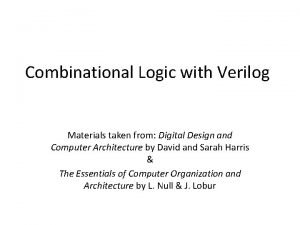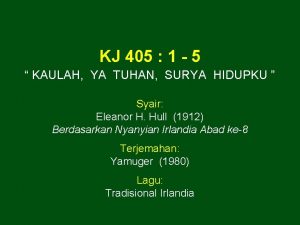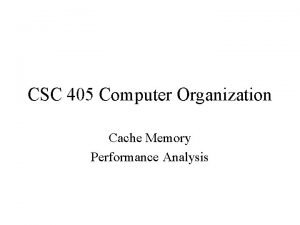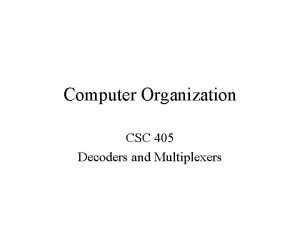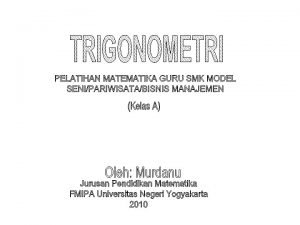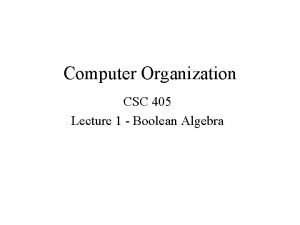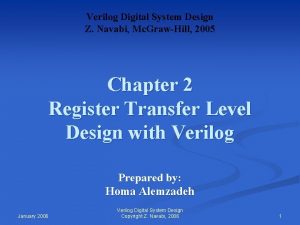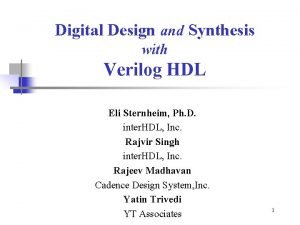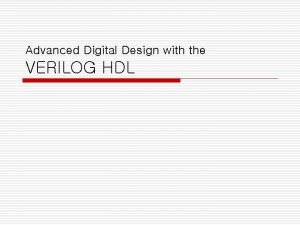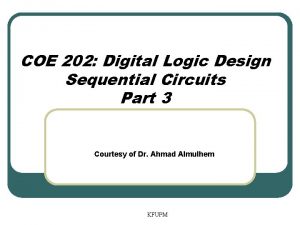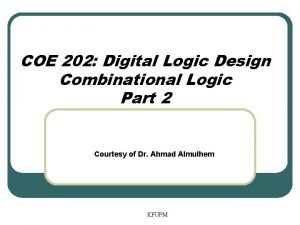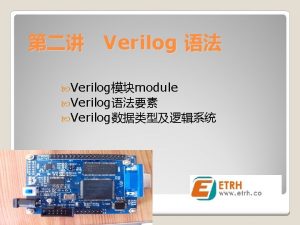COE 405 Introduction to Logic Design with Verilog








![Definition of a Module: Verilog-2005 n Module & Port Declaration: module [module-name] #(parameter declarations) Definition of a Module: Verilog-2005 n Module & Port Declaration: module [module-name] #(parameter declarations)](https://slidetodoc.com/presentation_image_h/aa152de2e73cb0c7e7faaa10fd3f3809/image-9.jpg)














![Module Instantiation module Add_rca_4 (output c_out, output [3: 0] sum, input [3: 0] a, Module Instantiation module Add_rca_4 (output c_out, output [3: 0] sum, input [3: 0] a,](https://slidetodoc.com/presentation_image_h/aa152de2e73cb0c7e7faaa10fd3f3809/image-24.jpg)
![Module Instantiation module Add_rca_16 (output c_out, output [15: 0] sum, input [15: 0] a, Module Instantiation module Add_rca_16 (output c_out, output [15: 0] sum, input [15: 0] a,](https://slidetodoc.com/presentation_image_h/aa152de2e73cb0c7e7faaa10fd3f3809/image-25.jpg)


















- Slides: 43

COE 405 Introduction to Logic Design with Verilog Dr. Aiman H. El-Maleh Computer Engineering Department King Fahd University of Petroleum & Minerals

Outline n Introduction n Definition of a module n Gate-level modeling n Verilog primitives n Verilog Syntax n Verilog Data Types n Module instantiation n Organization of a Testbench for Verifying a Unit Under Test (UUT) n Propagation, inertial and transport delay n Truth Table Models of Combinational and Sequential Logic with Verilog 1 -2

Introduction n Verilog is one of the hardware description languages (HDL) available in the industry for hardware designing. n Verilog is a standard HDL (IEEE 1364 -1995, 2001, 2005) n It allows designers to design at Behavior Level, Register Transfer Level (RTL), Gate level and at switch level. n Parallel not serial (Not like C language). n Verilog can describe everything from single gate to full computer system. 1 -3

Why use HDL ? n Digital systems are highly complex; millions of transistors. n For large digital systems, gatelevel design is very difficult to achieve in a short time. n Verilog allows hardware designers to express their designs with behavioral constructs, deferring the details of implementation to a l © Intel P 4 Processor later stage in the final design. l Introduced in 2000 n Computer-aided design tools aid in l 40 Million Transistors the design process. l 1. 5 GHz Clock 1 -4

A Verilog Model n A digital system can be described at several levels of details (more details means more design entry time!): • Gate-level Net-list similar to schematic or bread boarding • Register-transfer-level (RTL): Describing logic between • n registers using simple assignment statement (two types of assignments; continuous and procedural) logic synthesis tools convert it to gate-level netlist (gates and FFs) Behavioral description: programming-like structures (if-thenelse, case, loops …etc) to describe what the circuit does (i. e. behavior) rather than how requires a high-level synthesis tool to synthesize an RTL implementation (DP & CU) which can then be synthesized into gate-level netlist. A digital system is described as a set of modules Basic building block encapsulation 1 -5

Definition of a Module n The <module name> is an identifier that uniquely names the module. n The <port list> is a list of input, inout and output ports which are used to connect to other modules. n Interface: port and parameter declaration n Body: Internal part of module n Add-ons (optional) 1 -6

The Module Interface This is the old Verilog (Verilog-95) Port List Port Declaration 1 -7

The Module Interface 1 -8
![Definition of a Module Verilog2005 n Module Port Declaration module modulename parameter declarations Definition of a Module: Verilog-2005 n Module & Port Declaration: module [module-name] #(parameter declarations)](https://slidetodoc.com/presentation_image_h/aa152de2e73cb0c7e7faaa10fd3f3809/image-9.jpg)
Definition of a Module: Verilog-2005 n Module & Port Declaration: module [module-name] #(parameter declarations) ( [mode] [ data-type] [port-names] , . . . [mode] [ data-type] [port-names] ); Mode: input, output or inout Data-Type: wire, reg or integer (scalar or array) 1 -9

Example 1 -10

Gate Level Modeling (structural) n Net-list description: built-in primitives gates An undeclared identifier is treated by default as a wire 1 -11

Verilog Primitives for Modeling Combinational Logic Gates n Verilog has 26 primitives for modeling combinational logic gates: • and • or • not • buf • xor • nand • nor • xnor • bufif 1, bufif 0 • notif 1, notif 0 1 -12

Primitive Pins Are Expandable nand (y, in 1, in 2); nand (y, in 1, in 2, in 3, in 4); The output port of a primitive must be the first in the list of ports. 1 -13

Full Adder Model module fadd (output co, s, input a, b, c); wire n 1, n 2, n 3; xor (n 1, a, b) ; xor (s, n 1, c) ; nand (n 2, a, b) ; nand (n 3, n 1, c) ; nand (co, n 3, n 2) ; endmodule 1 -14

Verilog Syntax n Identifiers: • Composed of letters, digits, the underscore character (_), and • • the dollar sign ($). $ is usually used with a system task or function The first character of an identifier must be a letter or underscore Verilog is a case-sensitive language D_BUS is different from D_Bus n Keywords: predefined identifiers that are used to describe language constructs. E. g. module, always, wire …etc. Can not be used as user-defined identifiers n White space: space, tab, and newline characters are used to separate identifiers and can be used freely in the Verilog code 1 -15

Verilog Syntax n Comments: two forms; one-line comment starts with // and multiple-line comment is encapsulated between /* and */ // This is a comment /* This i s comment line 1. This i s comment line 2. This i s comment line 3. * / 1 -16

Verilog Data Types n Four-valued system: n Two groups of Data Types: net and variable. n Net group: • 0: for "logic Low, or a false condition • I: for "logic High", or a true condition • z: for the high-impedance state • x: for an unknown value (in simulations) • wire: could be 1 -bit or array (e. g. wire a; wire [3: 0] sum; ) • wand: wired-and • wor: wired-or • supply 0: a net connected to ground • supply 1: a net connected to power supply 1 -17

Verilog Data Types n Variable group: represent abstract storage in behavioral modeling (the inferred circuit may or may not contain physical storage components) • reg: The most commonly used data type in this group • integer: supports numeric computation in procedural • statements real, time, and realtime: can only be used in modeling and simulation n Variables hold their value until an assignment statement changes them. n Variables are assigned values within procedural statements (within always or initial block). 1 -18

Integer Numbers in Verilog n Constant numbers can be specified in decimal, hexadecimal, octal, or binary format n Integer numbers can be specified as: • Syntax: <size>'<radix><value> (size is in number of bits) • • first character so use it for better clarity. Examples: 12’b 1011_1100_0010, ‘h. A 8, 8’d 15) When <size> is smaller than <value>, then left-most bits of <value> are truncated • Sized or unsized numbers ( Unsized numbers are 32 bits ) • In a radix of binary, octal, decimal, or hexadecimal • Radix and hex digits (a, b, c, d, e, f) are case insensitive • Spaces are allowed between the size, radix and value • The character (_) is legal anywhere in a number except as the 1 -19

Constants n A constant is declared with keyword parameter, which declares and assigns value to the constant. n Constant expressions maybe used in value declaration. n A value of a constant may not change during simulation. n Examples: • parameter high_index = 31; • parameter width = 32, depth = 1024; • parameter byte_size = 8, byte_max = byte_size-1; • parameter initial_state = 8’b 1001_0110; 1 -20

Module Instantiation n Two ways to connect the ports of the instantiated module to the signals in the instantiating module: • 1. By name: [module-name] [instance-name] module Add_half (output c_out, sum, input a, b); ( xor (sum, a, b); . [port-name] ( [signal-name] ) , and (c_out, a, b); . [port-name] ([signal-name]), endmodule ); Add_half M 1 (. c_out(Cout), . sum(Sum), . a(A), . b(B)); • 2. By order: Add_half M 2 (Cout, Sum, A, B); 1 -21

Module Instantiation 1 -22

Module Instantiation module Add_half (output c_out, sum, input a, b); xor M 1 (sum, a, b); and M 2 (c_out, a, b); endmodule Add_full (output c_out, sum, input a, b, c_in); wire w 1, w 2, w 3; Add_half M 1 (w 2, w 1, a, b); Add_half M 2 (w 3, sum, c_in, w 1); or M 3 (c_out, w 2, w 3); endmodule 1 -23
![Module Instantiation module Addrca4 output cout output 3 0 sum input 3 0 a Module Instantiation module Add_rca_4 (output c_out, output [3: 0] sum, input [3: 0] a,](https://slidetodoc.com/presentation_image_h/aa152de2e73cb0c7e7faaa10fd3f3809/image-24.jpg)
Module Instantiation module Add_rca_4 (output c_out, output [3: 0] sum, input [3: 0] a, b, input c_in); wire c_in 2, cin 3, c_in 3; Add_full M 1 (c_in 2, sum[0], a[0], b[0], c_in); Add_full M 2 (c_in 3, sum[1], a[1], b[1], c_in 2); Add_full M 3 (c_in 4, sum[2], a[2], b[2], c_in 3); Add_full M 4 (c_out, sum[3], a[3], b[3], c_in 4); endmodule 1 -24
![Module Instantiation module Addrca16 output cout output 15 0 sum input 15 0 a Module Instantiation module Add_rca_16 (output c_out, output [15: 0] sum, input [15: 0] a,](https://slidetodoc.com/presentation_image_h/aa152de2e73cb0c7e7faaa10fd3f3809/image-25.jpg)
Module Instantiation module Add_rca_16 (output c_out, output [15: 0] sum, input [15: 0] a, b, input c_in); wire c_in 4, c_in 8, c_in 12; Add_rca_4 M 1 (c_in 4, sum[3: 0], a[3: 0], b[3: 0], c_in); Add_rca_4 M 2 (c_in 8, sum[7: 4], a[7: 4], b[7: 4], c_in 4); Add_rca_4 M 3 (c_in 12, sum[11: 8], a[11: 8], b[11: 8], c_in 8); Add_rca_4 M 4 (c_out, sum[15: 12], a[15: 12], b[15: 12], c_in 12); endmodule 1 -25

Module Instantiation module Comp_2_str (output A_gt, _B, A_lt_B, A_eq_B, input A 0, A 1, B 0, B 1); nor (A_gt_B, A_lt_B, A_eq_B); or (A_lt_B, w 1, w 2, w 3); and (A_eq_B, w 4, w 5); and (w 1, w 6, B 1); and (w 2, w 6, w 7, B 0); and (w 3, w 7, B 0, B 1); not (w 6, A 1); not (w 7, A 0); xnor (w 4, A 1, B 1); xnor (w 5, A 0, B 0); endmodule 1 -26

Module Instantiation module Comp_4_str (output A_gt, _B, A_lt_B, A_eq_B, input A 3, A 2, A 1, A 0, B 3, B 2, B 1, B 0); wire w 1, w 0; Comp_2_str M 1 (A_gt, _B_M 1, A_lt_B_M 1, A_eq_B_M 1, A 3, A 2, B 3, B 2); Comp_2_str M 0 (A_gt, _B_M 0, A_lt_B_M 0, A_eq_B_M 0, A 1, A 0, B 1, B 0); or (A_gt_B, A_gt_B_M 1, w 1); and (w 1, A_eq_B_M 1, A_gt_B_M 0); and (A_eq_B, A_eq_B_M 1, A_eq_B_M 0); or (A_lt_B, A_lt_B_M 1, w 0); and (w 0, A_eq_B_M 1, A_lt_B_M 0); endmodule 1 -27

Test Methodology n Modeling begins with a complex functional unit and partitions it in a top-down fashion to enable design of simpler units. n Systematic verification begins with simpler units and moving to more complex units in design hierarchy. n To verify functionality of a digital circuit build a test bench that applies stimulus patterns to the circuit and collect responses. n Responses can be displayed or compared to a correct response. n Test bench is a separate Verilog module. 1 -28

Organization of a Testbench for Verifying a Unit Under Test (UUT) 1 -29

Testbench Example module t_Add_half(); wire sum, c_out; reg a, b; Add_half M 1 (c_out, sum, a, b); initial $monitor("time=%0 t a=%d b=%d Cout =%d Sum=%d ", $time, a, b, c_out, sum) ; initial begin #10 a=0; b=0; #10 b=1; #10 a=1; #10 b=0; endmodule 1 -30

Testbench Example n The keyword initial declares a single-pass behavior that begins executing when the simulator is activated. n Statements within begin and end block keywords are called procedural statements. n Procedural statements execute sequentially n # is a delay control operator n A delay control operator preceding procedural assignment statement suspends its execution and the execution of subsequent statements for specified delay time n reg declaration ensures that variables will keep their value until the next procedural assignment statement n $finish ends simulation 1 -31

Testbench Example module t_Add_half(); wire sum, c_out; reg a, b; Add_half M 1 (c_out, sum, a, b); initial begin #100 $finish; end initial fork #10 a=0; #10 b=0; #20 b=1; #30 a=1; #40 b=0; join endmodule 1 -32

Testbench Template module t_DUTB_name(); // substitute the name of the UUT reg ----; // declaration of register variables for // primary inputs of the UUT wire ----; // declaration of primary outputs of UUT parameter time_out= // provide a value UUT_name M 1 (UUT ports go here); initial $monitor() // specification of signals to be // monitored and displayed as text initial time_out $finish // stopwatch to ensure termination // of simulation initial begin // behavioral statements generating // wavefroms to input ports end 1 -33 endmodule

Propagation Delay module Add_full_unit_delay(output c_out, sum, input a, b, c_in); wire w 1, w 2, w 3; Add_half_unit_delay M 1 (w 2, w 1, a, b); Add_half_unit_delay M 2 (w 3, sum, w 1, c_in); or #1 M 3 (c_out, w 2, w 3); endmodule Add_half_unit_delay (output c_out, sum, input a, b); xor #1 M 1 (sum, a, b); and #1 M 2 (c_out, a, b); endmodule 1 -34

Propagation Delay n To set a certain unit for time units, use the directive `timescale n `timescale 1 ns / 1 ps directs the simulator to interpret numerical time variables as having units of nanoseconds with a resolution of picoseconds 1 -35

Inertial Delay n Propagation delay in Verilog obeys inertial delay model. n Verilog uses the propagation delay of a gate as minimum width of an input pulse that could affect output. 1 -36

Transport Delay n Propagation delay across a wire is modeled as transport delay i. e. narrow pulses are not suppressed n Example • wire #2 A_long_wire declares that A_long_wire has a transport delay of two time steps. 1 -37

Truth Table Models of Combinational and Sequential Logic with Verilog n Verilog supports truth-table models of combinational and sequential logic. n A mechanism for building user-defined primitives (UDPS). n UDPs are declared in same way as modules with encapsulation of keywords primitive …endprimitive n The output and inputs of a UDP must be scalar. n They can be instantiated just like built-in primitives with or without propagation delay. 1 -38

Truth Table Models of Combinational and Sequential Logic with Verilog 1 -39

Truth Table Models of Combinational and Sequential Logic with Verilog n The ? Shorthand notation represents iteration of the table over the values 0, 1, and x in the table i. e. , don’t care on the input table //Select 0 0 1 1 ? ? endtable a 0 1 ? ? 0 1 b ? ? 0 1 : : : : mux_out 0; 1; 1 -40

Truth-Table Model of Transparent Latch n The output of a sequential UDP must be declared to have type reg primitive latch_rp (output reg q_out, input enable, data); table // enable data state q_out/next_state 1 1 : ? : 1; 1 0 : ? : 0; 0 ? : -; // - means keep x 0 : -; // same state x 1 : -; endtable endprimitive 1 -41

Truth-Table Model of D-type Flip-Flop 1 -42

Truth-Table Model of T-type Flip-Flop primitive T_prim (output reg Q, input clk, rst_b, toggle); table // clk rst_b toggle state Q/next_state ? 0 ? : 0 ; // rst_b setting flip flop to 0 (01) 1 0 : ? : - ; // Rising clock edge (01) 1 1 : 0 : 1 ; (01) 1 1 : 0 ; (1? ) 1 ? : - ; // Falling clock ? 1 (? ? ) : ? : - ; // Steady clock, ignore data ? (? 1) ? : - ; // Steady clock, ignore data endtable endprimitive 1 -43
 Coe logic
Coe logic Verilog combinational logic
Verilog combinational logic Bag mask ventilation
Bag mask ventilation Lan 405
Lan 405 Kj405
Kj405 David rockefeller memoirs page 405
David rockefeller memoirs page 405 Lan 405
Lan 405 405 000 in scientific notation
405 000 in scientific notation A basketball star exerts a force of 3225
A basketball star exerts a force of 3225 Adq 405 getnet
Adq 405 getnet How to calculate upper bound
How to calculate upper bound Csc 405
Csc 405 Csc 405
Csc 405 Ukuran sudut
Ukuran sudut Micb 405
Micb 405 Norma portuguesa 405
Norma portuguesa 405 What is srf in econometrics
What is srf in econometrics Csc 405
Csc 405 First order logic vs propositional logic
First order logic vs propositional logic First order logic vs propositional logic
First order logic vs propositional logic First order logic vs propositional logic
First order logic vs propositional logic Combinational logic circuit vs sequential
Combinational logic circuit vs sequential Tw
Tw Software development wbs
Software development wbs Is it x y or y x
Is it x y or y x Combinational logic sequential logic 차이
Combinational logic sequential logic 차이 Logic chapter three
Logic chapter three Digital system design using verilog
Digital system design using verilog Verilog
Verilog Hierarchical design in verilog
Hierarchical design in verilog Advanced digital design with the verilog hdl
Advanced digital design with the verilog hdl Verilog hdl: a guide to digital design and synthesis
Verilog hdl: a guide to digital design and synthesis Psgtechs coe indutech
Psgtechs coe indutech Sfa coe
Sfa coe Coe kfupm
Coe kfupm Coe kfupm
Coe kfupm Stefan wallin
Stefan wallin Center of excellence maturity model
Center of excellence maturity model Coe 301
Coe 301 Coe202
Coe202 Pos expression can be implemented using
Pos expression can be implemented using Consensus theorem
Consensus theorem What makes great teaching
What makes great teaching Openstack coe
Openstack coe

